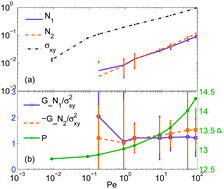Stress–structure relation in dense colloidal melts under forward and instantaneous reversal of the shear
Abstract
A dense supercooled colloidal melt in forward shear from a quiescent state shows overshoot in the shear stress at 10% strain with an unchanged fluid structure at equal stress before and after overshoot. In addition, we find an overshoot in the normal stress with a monotonic increase in the osmotic pressure at an identical strain. The first and second normal stresses become comparable in magnitude and opposite in sign. A functional dependence of the steady state stress and osmotic pressure with the Péclet number demonstrates the signature of crossover between Newtonian and nearly-Newtonian regimes. Moreover, instantaneous shear reversal from a steady state exhibiting the Bauschinger effect, where a strong history dependence is observed depending on the time of the flow reversal. The distribution of the particulate stress and osmotic pressure at the point of the flow reversal is shown to be a signature of the subsequent response. We link the history dependence of the stress–strain curves to changes in the fluid structure measured through the angular components of the radial distribution function. A uniform compression in the transition from forward to reversed flowing states is found.


 Please wait while we load your content...
Please wait while we load your content...